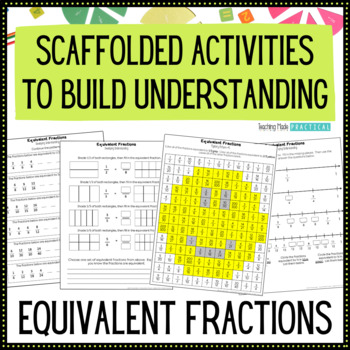Equivalent Fractions Activities, Worksheets & Review , Games, Coloring, Practice
- PDF
What educators are saying
Also included in
- This huge fractions bundle contains 7 of my fraction resources, covering everything from understanding 1/2, to using 1/2 as a benchmark fraction, to fractions on a number line, to equivalent fractions, to comparing and ordering fractions, and more. Save over 30% when you buy the mega bundle!This fraPrice $18.75Original Price $27.75Save $9.00
Description
Help make teaching equivalent fractions easier and more understandable for your students with these low prep activities and worksheets. This unit starts with a basic introduction to equivalent fractions, and then is scaffolded with visuals to help your students master this skill as the concepts get more difficult. The scaffolding also helps you differentiate more easily. Coloring activities, centers, and games are provided for additional equivalent fractions practice. And as an added bonus, most of these activities are no prep equivalent fraction resources - just print and go!
This is now available digitally using Google Slides as well as the printable version.
Save over 30% when you buy this as part of my Fractions: Mega Bundle which includes resources to practice fractions on a number line, comparing fractions, and more.
This resource includes:
- 10 equivalent fraction worksheets that help students develop a true understanding of equivalent fractions
- a "Find the Equivalent Fraction" Scavenger Hunt activity
- 4 fun mazes that can be used as no prep centers
- a "snowball fight" whole class activity
- 3 equivalent fraction coloring mystery pictures that make great centers
- a grading rubric and answer keys
Important Note: While this resource is now available digitally, it was designed for print. The scaffolding and games will be much more effective with the print version. Depending on your students' computer knowledge, some of the digital activities might require additional support. For example, students might need to be taught how to highlight cells in a table in order to be successful with the mazes and mystery pictures.
These activities can be used in upper elementary for small groups, assessments/test, center activities, explicit instruction, math workshop, for special education students, for equivalent fraction stations / workstations, and more.
This directly addresses common core standards: 3.NF.A.3.A, 3.NF.A.3.B, and 4.NF.A.1 for 3rd grade and 4th grade students. They make a great equivalent fraction review for 5th grade students.
Check out the preview everything included in this resource.
You might also be interested in:
Kalena Baker, Teaching Made Practical






